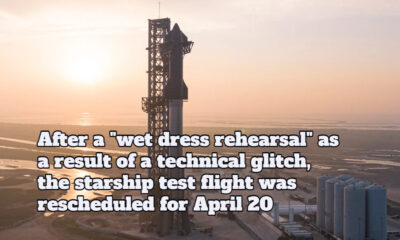Science –Technology
Why Should 2023 Be Called the “Year of the Lunar Landers”?
Published
1 year agoon

New year, new missions.
The year 2023 may go down in history as the Year of the Lunar Landers, with a launch schedule jam-packed with robotic missions to Earth’s nearest neighbor.
The James Webb Space Telescope, a new super-sensitive observatory in the sky, and the
maiden voyage of Artemis, NASA’s moon-to-Mars campaign that will soon return humans to
deep space, ushered in the new Space Age last year. Not to mention the first time the
United States space agency intentionally moved an asteroid. As a result of those success
stories, science journals are bound to be brimming with new discoveries, broadening our
understanding of the universe.
Though 2023 has big shoes to fill in the universe, it promises to keep launch pads hot. Many
upcoming missions will lay the groundwork for NASA’s moon endeavors, transporting
supplies and experiments to the moon’s surface in advance of astronauts’ arrival in 2025 or
later, as well as launching a future lunar economy. This is largely due to NASA’s Commercial
Lunar Payload Services Program, which was established in 2018 to recruit the private sector
to assist in the delivery of cargo to the moon.
Here’s a look at the space missions that will (hopefully) launch this year, as well as a few keys
dates to mark on your calendar for missions that are already in the works.
A word of advice: think about these no-earlier-than dates. We’ll quote Jim Free, NASA
associate administrator from Kennedy Space Center in Cape Canaveral, Florida, when it
comes to rocket launches, which are frequently delayed for a variety of reasons: “Plan a
week’s vacation in Florida and you might see a launch.”
Why Should 2023 Be Called the “Year of the Lunar Landers”
1. Mars lander to study moondust and other topics: March 2023
NASA chose commercial partner Intuitive Machines to send a lander to Schroter’s
valley on the moon’s nearside. During the IM-1 mission, the Nova-C lander will
Investigate how rocket exhaust and space weather affect the lunar surface. The
The mission is scheduled to launch from Cape Canaveral on a SpaceX Falcon 9 rocket.
The spacecraft, a six-sided cylinder on six legs, will transport five NASA instruments as
as well as unrelated commercial cargo, as well as demonstrate advanced landing technology.
Fun fact: The lander will stay warm in frigid space by wearing a coat, just like most
people. Intuitive Machines collaborated with Columbia Sportswear to use some of its
insulation material on the spacecraft rather than reinventing the wheel.
2. Lander is preparing for a future ice-mining mission, which will take place between
January and March 2023.
Astrobotic, another commercial partner, was contracted by NASA to deliver
instruments and experiments to the lunar surface. The Peregrine-1 mission is
scheduled to launch from Cape Canaveral in the first quarter of 2023 on a United
Launch the Alliance Vulcan Centaur rocket.
Peregrine is a prototype for the lander Astrobotic will use to send NASA’s VIPER rover
to the moon to drill for ice. It will carry prototypes of instruments that NASA wants to
test before the important, crewless water-hunting mission scheduled for 2024. The
boxy four-legged Peregrine will land on the “Lake of Death,” a lava plain on the
moon’s nearside’s northeastern limb.
3. SpaceX’s Starship will make its first orbital spaceflight in 2023.
SpaceX’s Starship, a 400-foot-tall stainless-steel contraption, could have roughly twice
the launch power of NASA’s mega moon rocket.
The Starship is a super-heavy-class rocket and spaceship that NASA intends to use to
transport astronauts to the moon’s surface from its future lunar-orbiting base. This is
in addition to Elon Musk’s vision of one day colonizing Mars with a fleet of Starships.
When will Musk launch this monstrous machine into orbit for the first time? In true
SpaceX fashion, the company is keeping the rest of us in the dark. Musk stated at a
public event last February that it would happen before the end of 2022.
4. Japan will launch its own spacecraft to the moon in April 2023.
Not every one of these unmanned moon missions will launch from Florida’s Space
Coast. The Japanese space agency, JAXA, will send its own lunar lander to
demonstrate advanced precision landing with a small explorer.
The SLIM mission, which stands for Smart Lander for Investigating Moon, is a
rideshare flight that carries a variety of payloads. It is expected to launch in Japan
Tanegashima Space Center.
5. India gets a second chance after a failed moon mission: June 2023
Following the Chandrayaan-2 mission, in which the spacecraft crashed while
attempting to land in 2019, India’s space agency will attempt to send a lander and
rover to the highlands of the moon’s south pole once more.
The Indian Space Research Organization plans to use a similar rover to the one used in
the previous failed mission during the next Chandrayaan-3 mission, scheduled for
mid-2023, but with improvements to help it stick the landing. The mission will take off
from a launch pad on Sriharikota, a barrier island in southeastern India, on an LVM 3
heavy-lift rocket.
6. NASA moon rover delivery mission: June 2023
Later this year, contractor Intuitive Machines will be in charge of sending a new NASA
rover to the moon’s south pole. This mission, known as IM-2 or Prime-1, is designed
to land and test a drill and mass spectrometer, which detects the types of particles in
a substance.
Another spacecraft, NASA’s Lunar Trailblazer, is currently scheduled to join this flight.
The tiny satellite will orbit the moon in order to map the locations of lunar water. The
mission will launch from Cape Canaveral on a SpaceX Falcon 9 rocket no later than
June.
7. Russia will launch its first moon probe since the 1970s in July 2023.
The former Soviet Union, which disintegrated in 1991, sent numerous robotic
spacecraft to the moon, but the upcoming Luna 25 mission will be the first in post-
Soviet Russian history.
The Russian space agency, Roscosmos, wants to send the lander to the moon’s south
pole. It will investigate the moon’s soil and atmosphere and aid in the development of
landing technology. The spacecraft will be launched from Kazakhstan’s Vostochny
Cosmodrome on a Soyuz-2 rocket with a Fregat upper stage.
Prior to Russia’s invasion of Ukraine, the European Space Agency was expected to join
the mission by providing a camera to aid in landing. However, due to the geopolitical
conflict, Europe withdrew from the deal, as well as its other Russian space
collaborations.
8. NASA will search for its first metal asteroid in October 2023.
And now for a palate cleanser from all of those lunar missions: NASA will study an
asteroid primarily composed of metals such as iron and nickel from orbit for the first
time.
The number 16 space rock Psyche has long piqued the interest of planetary scientists,
who believe it is all that remains of an ancient planet after collisions stripped away its
rocky surface.
But keep your hats on. If the spacecraft launches on time in October 2023, it will not
arrive at its primary asteroid belt destination until August 2029. About three years
into its journey, the orbiter requires a gravity assist from Mars. NASA intends to
launch the mission from Cape Canaveral on a SpaceX Falcon Heavy rocket.
9. A European mission will visit Jupiter’s moons in 2023.
The European Space Agency is planning a mission to Jupiter, where it will fly on three
of the planet’s icy moons and orbit one, in particular, Ganymede.
The “Juice” mission (an abbreviation for Jupiter Icy Moons Explorer, though perhaps
fitting for Ganymede’s mythological namesake, who served as Jupiter’s personal
cupholder) is intended to focus its research on Ganymede as a potential habitat,
looking at its ocean layers and atmosphere.
The European Space Agency (ESA) intends to launch the spacecraft on an Ariane 5
rocket from its spaceport in French Guiana, on the South American continent. After a
seven-year space voyage, it will orbit Jupiter in 2031 with gravity assistance from
Earth and Venus. Along the way, the spacecraft will look at Jupiter’s moons Callisto
and Europa.
Other space mission events in 2023
- The European Space Agency’s Bepi-Colombo mission is scheduled to make its
third Mercury flyby on June 20, 2023. - On August 21, 2023, NASA’s Parker Solar Probe will conduct its sixth Venus
flyby as part of its sun-studying mission. - On September 24, 2023, NASA’s OSIRIS-Rex mission will return to Earth after a
long journey to the carbon-based asteroid Bennu. The spacecraft that - The collected samples are expected to land at the Utah Test and Training
Range, west of Salt Lake City, in October 2020.
You may like
-


Twitter’s paywall system has been removed from its application programming interface
-


After a “wet dress rehearsal” as a result of a technical glitch, the starship test flight was rescheduled for April 20
-


Q1 2023, Netflix added 1.75 million new subscribers. Ad-Supported Tier Following Crackdown on Password Sharing
-


Elon Musk will develop ‘truth-seeking’ AI to compete with Google and Microsoft in the AI race
-


Sundar Pichai, the CEO of Google, alluded to more job cuts at the tech giant
-


Truecaller Launches Live Caller ID for iPhone Users
